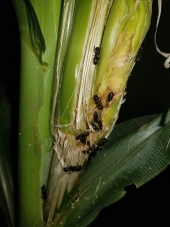

J Blair wrote:this year I was diligent about cover cropping, mulching (with cardboard, and some very weedy/grass areas with black plastic) in an attempt to not have bare soil. One unfortunate result was that voles have found the cover to be quite convenient. They ate all my brussel sprout plants almost as soon as I set them out. I also think they are eating the stems of my squash - not the squash, just the main stem which of course kills the whole plant! At first I thought it was gophers (which I continually trap), but I have found pathways under the mulch, and I saw a vole running through the squash, so now I think it is probably voles.
I don't want to leave the soil bare! Anyone have advice for having mulch and cover, and also not losing plants to voles?

C Gillis wrote:
Why in your opinion do you think that there arean't tens of thousands of Mark Shepard-style farms and systems being designed and built in the last years?

Carla Burke wrote: My understanding is that they mate for life, so the male to female breeding ratio is 1:1 - not exactly an economical ratio, like chickens.
tony uljee wrote:been to some ostrich ranches in s.africa, they are in the drier regions very sparse vegetation lots of open ground, these birds range far in wilder situations but ranched sees them in large high fenced paddocks and fed a formulated type ration plus fresh cut feed, they were mostly grown for the leather/hide industry ,higher end of it ,shoes and luggage bags ,briefcases and smaller pieces made into hats and belts ,sandals ,wallets and trinkets being the last end use.The feathers were in demand awhile ago as trim decoration in fashion clothing industry, the meat and eggs were almost secondary to the operation .They were all special hybrid livestock ---much bigger than their wild relations --grown for size and feather colour/conformaty---for bigger hides and the pattern left in the hide after feathers .All thorn tree or barb wire excluded from paddocks , bred from a mix of sub species from african countries. Kept in flocks of age,size and sex rated , breeding stud males kept away and sub standard males used as a foster dad --they help rear , So not an easy animal to just smallhold in low numbers i think----and dont wear sunglasses ,watches ,rings in ears or on fingers or any thing with buttons.
Ryan M Miller wrote:I just learned that another drawback to using fennel as a cover crop is that the plant is a perennial and not an annual. This may cause problems when it comes time to chop up the plants into the soil, especially if it can clone itself from root fragments like dandelions or creeping thistle. I'll do some more reading.

Rusty Shacklefurd wrote:Sorry for the resurrected post but this is the first result in Google (2018) so I thought I would help other people looking also.
I can not see any aphids but I am also a very novice gardener so I doubt everything I do.
It seems that these ants are just ripping up my corn plant and drinking from it or possibly eating it also?
Please help. I am going to try DE but from what I have read ants won't/can't eat fibers like that and I am intrigued to hear from someone who knows anything.


If this forum doesn't allow new users to post images in posts here is direct links
https://i.imgur.com/Z9Uvl1S.jpg
https://i.imgur.com/fZIiG40.jpg
Ann Torrence wrote:One of my 5 goals is to sell something at our tiny farmers' market this summer, as a practice run for when we have our fruit products. We have a "real" farmer who brings in veg and goat cheese; he started the market and I'm not going to compete with him. But no one sells flowers. I'm going to try it. Annuals, but if it works, it would be pretty easy to add things like echinacea, lilies, etc to the mainframe project. And our market is small, mostly weekend homeowners and retirees, so it's more of having a presence until the fruit comes in and it's not a huge investment to try it. Worst case scenario is that I get to hang out with my neighbors for a couple hours a week and fill my house with cut flowers.
Had anyone done this? Tips?
 you might get suprise. it may not be a stall it might be something even better.
you might get suprise. it may not be a stall it might be something even better.